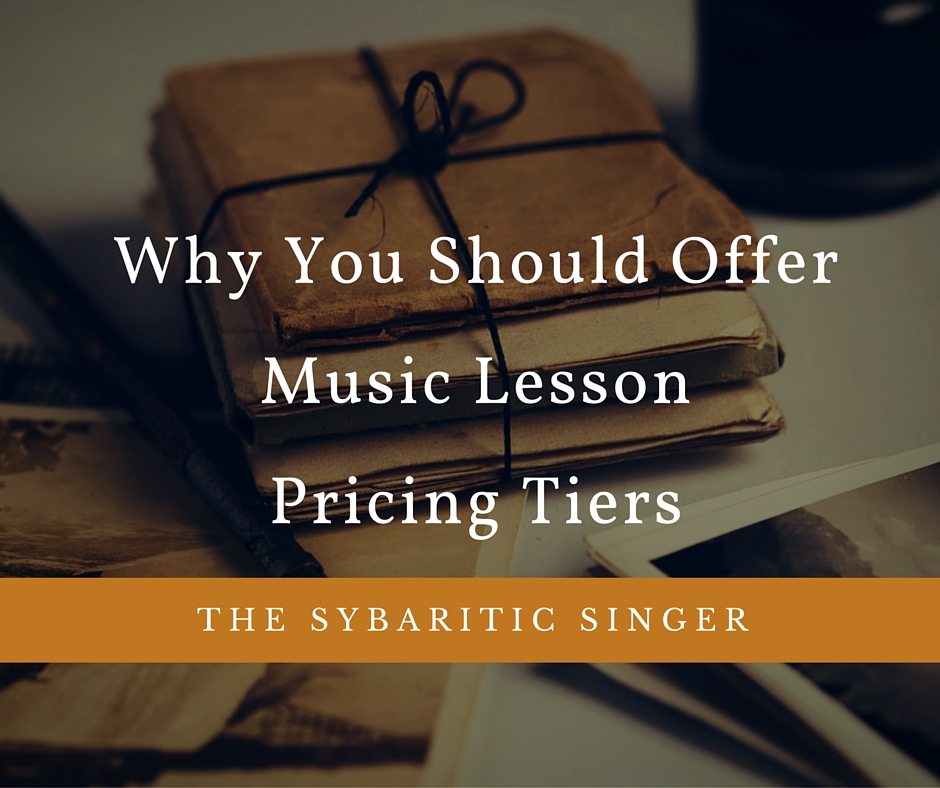People invest in services for different reasons. Some families want to give their children music lessons because they think that learning how to play an instrument is simply “what one does.” Other families believe that their children have a real desire to go on to become a professional in the field. There are even families who are begrudgingly committing to music lessons because it is required by their child’s school. Because each family and each student has a different reason for trusting you to provide excellent instruction, it is important to base your prices on benefits, not just your costs. (We already covered “what to charge” in the special email content. If you didn’t get a chance to read that post, sign up now and it’ll be winging its way to your inbox in no time.)
Be prepared: some people will always think that the price is too high no matter what you charge for lessons. Sadly, what works for Wal-Mart will not work for you. You are not a big box store. You are a boutique operation devoted to individual instruction. That is a rarer commodity these days than you think. Did you know that offering a narrow range of prices can actually help you bring in more students to your studio?
Sadly, what works for Wal-Mart will not work for you. You are not a big box store. You are a boutique operation devoted to individual instruction.
Multiple Pricing Tiers for Music Lesson Studios
This is not a foreign concept to most studio teachers regardless of academic institution-based or private studio. Students are usually charged different prices for certain blocks of time like 30 minute or hour-long lessons. Those prices are determined in the “what you charge” phase. This post is more about how a range of prices can increase profitability for your studio as something of a messaging/marketing tool.
Before we get to the options, you must decide what you want as your backbone option for the studio. Into which lesson option would you like most of your clients to land? For my studio, I want the bulk of my students to be in 30 minute lessons. Business-wise, it is best for me to maintain the schedule and the bottom line of the studio with that being the backbone option. For others, they want to only teach hour-long lessons. If that is the case for you, you will want to structure your options so that looks like the best option for most people.
Option 1
Listing your prices for lessons based on blocks of time – 30 minutes or an hour – presents the choice to your clients as “What do you have time and budget for now based on your limited knowledge of the benefits of voice lessons?”
Option 2
When you start to provide a range of options, you are able to direct your clients to what would be best for them and use their desires to help your income. Furthermore, with this range of options, you are able to lead their eye to your backbone option. That is the one that keeps your studio at an even keel.
Here’s an alternative to option one that helps with your messaging (keep in mind these prices are made-up numbers used as an example):
Diva Town Voice Lessons
- Group Lessons (group lessons offered by voice part, once a week, day TBD from 6:00-6:30pm, ideal for beginning voice students.) – Price: $15 per lesson
- Individual Voice Lessons (30 Minutes, once a week, ideal for early high school students.) – Price: $30 per lesson
- Advanced Voice Lessons (60 Minutes, once a week, ideal for HS junior and seniors and other advanced students.) – Price: $60 per lesson
- Select Voice Bootcamp (1 week of exclusive, daily lessons; ideal for advanced students with busy schedules) – Price: $350 per week
With this type of breakdown you are able to message to your budget buyer as well as your premium buyer. When they are able to see a range of prices they can gravitate to the option that best fits their needs without being confused. Notice that I didn’t just list the time blocks and the price.
With this tiered pricing system you are able to message to your budget buyer as well as your premium buyer.
By adding specific information, I’m guiding them to make decisions based on age, skill level, budget, schedule availability, and more. At this point, you are definitely beyond asking them if they want voice lessons and you are into asking them which level of voice lessons they need. You aren’t pulling the wool over anyone’s eyes. Your clients are going to be aware of your marketing but they will be more appreciative of your ability to direct them into the right option for their child.
Subscription Add-Ons
As a lesson teacher, you are essentially creating a music education subscription service. The idea is that you want them to keep coming back for lessons month after month. Having a solid idea of how many subscribers at each level you need each month will make your teaching income more reliable and give you some data when it comes to marketing to new clients.
As a lesson teacher, you are essentially creating a music education subscription service.
After you’ve established that base of recurring clients, you may be wondering how you can possibly improve your revenue without raising your prices. An extremely happy client is likely to buy other things from you. Important note: before you consider marketing complementary services to your studio, make sure that you are providing a top-notch service to all of your students. It is imperative that you treat each student like your “best” student before encouraging them to sign up for other offerings. Once you have done that, do some brainstorming around what extras your students need. Can you offer a Show Choir Audition Bootcamp? Would they benefit from a Banish Stage Fright Workshop? I am certainly not advocating for any snake oil salesperson here. Sometimes there is simply not enough time to cover all of these things in a 30 minute lesson. This is an opportunity for them to focus on one goal in a concentrated setting.
Finally
Experimenting with price is one of the easiest ways to create better sustainability in your income and overall business. You will want to do some of the experimenting behind the scenes and in a “testing” capacity so that you are not changing prices on your clients too often. Even changing prices annually can make some clients jump ship. Before you go toggling prices haphazardly, experiment with offering more options and see if that gives you the bump you need.



